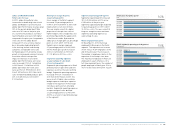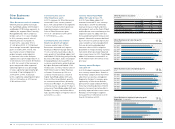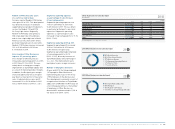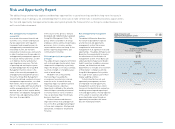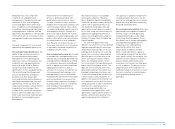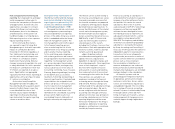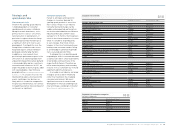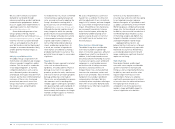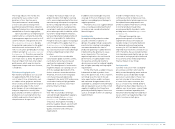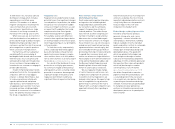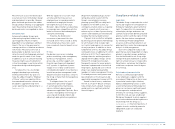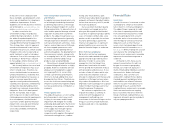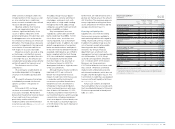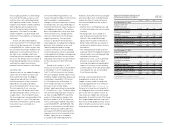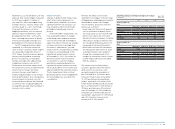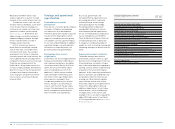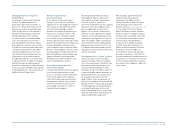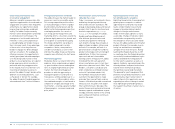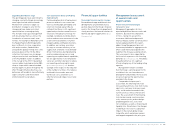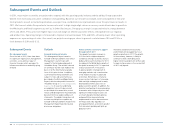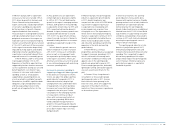Reebok 2010 Annual Report Download - page 169
Download and view the complete annual report
Please find page 169 of the 2010 Reebok annual report below. You can navigate through the pages in the report by either clicking on the pages listed below, or by using the keyword search tool below to find specific information within the annual report.
Group Management Report – Financial Review Risk and Opportunity Report 165
We continue to assess the likelihood of
occurrence of risks from product design
and development as possible. However,
given the broad spectrum of the adidas
Group’s product offering, on an aggregate
level, the potential financial impact has
decreased and is now regarded as minor.
Personnel risks
Achieving the adidas Group’s goal
of becoming the global leader in the
sporting goods industry is highly
dependent on our employees and their
talents. The loss of key personnel in
strategic positions is therefore an obvious
risk we face. We also face the risk of
being unable to identify, recruit and
retain the most talented people who best
meet the specific needs of our Group.
In addition, a lack of sufficient training
measures might cause the dilution of
critical knowledge, in particular within
the product design and development
area.
To reduce this risk, we strongly
engage in developing a motivating
working environment. Our goal is to
make the adidas Group the “Employer
of Choice” within our industry. Attrac-
tive reward and incentive schemes are
designed to supplement long-term
career opportunities and planning see
Employees, p. 115.
With the expansion of our own-retail
activities and the increase of our
employee base in emerging markets,
we believe that employee turnover
will slightly increase in the future.
Moreover, labour markets are becoming
increasingly more competitive, with the
battle for the most talented employees
constantly intensifying.
Therefore, the likelihood of
occurrence of personnel risks has
increased and is now assessed as likely.
If they materialise, these risks could
have a moderate financial impact on our
Group.
IT risks
Key business processes including
product marketing, order management,
warehouse management, invoice
processing, customer support and
financial reporting are all dependent
on IT systems. A significant systems
outage or loss of data could result in
considerable disruptions to our business.
Insufficient project management could
delay the execution of projects critical to
the Group or make them more expensive
than planned.
To mitigate these risks, our IT
organisation proactively engages
in system preventive maintenance,
service continuity planning and
adherence to applicable IT policies. Data
security is managed by restricting user
access based on job description and
adhering to data protection regulations.
We perform multiple backups at alter-
nating data centre locations for the
Group’s core enterprise resource
planning system (ERP) on a daily basis.
In addition, for the ERP system, our
contingency solution allows us to quickly
switch to a remote site if necessary –
without any loss of data. System security,
controls and reliability are reviewed and
tested by the Internal Audit function.
IT project risks are further mitigated
by utilising a proven project methodology
for all IT projects that includes tight
cost control and regular risk reviews for
all major projects. In addition to these
fundamental controls, the adidas Group
continued to focus on additional IT control
initiatives in 2010. The IT organisation’s
strategic direction and five-year plan is
aligned with the adidas Group’s overall
Route 2015 strategic business plan.
New quality reviews for major projects
have been implemented to ensure that
the progress, quality and costs of those
projects are regularly evaluated by
members of senior management. Finally,
IT-related processes and systems were
key components of the Group risk and
opportunity management review in 2010.
Based on these factors, we believe
the risk of a major IT default continues
to be unlikely. Such a default, however,
would result in a significant potential
financial impact.
Compliance-related risks
Legal risks
The adidas Group is exposed to the risk of
claims and litigation for infringement of
third-party trademark, patent and other
rights. To reduce this risk, new product
technologies, designs and names are
carefully researched to identify and avoid
potential conflicts with the rights of third
parties. We have further strengthened
our Intellectual Property department
resources to drive enhancements in our
patent portfolio, and in the reviewing and
analysis of third-party patents.
Due to the safeguards in place and
given that we are not dependent on single
products or product groups, we believe
that the likelihood that our Group might
infringe third-party trademark or patent
rights in a material way is only possible.
Nevertheless, we believe that litigation
could have a moderate financial impact
on our Group.
Social and environmental risks
We have a continuing responsibility
to our employees, suppliers and the
environment. Malpractice in these areas,
in particular human rights violations,
dubious employment practices as well
as environmentally harmful production
processes can have a significant impact
on the reputation and operational
efficiency of our Group and our suppliers.
To limit this risk, we have established
Workplace Standards to which suppliers
must conform before and during business
relationships with the Group see
Sustainability, p. 120. Internal inspections of
supplier factories verified by extensive
independent audits are conducted
regularly.


